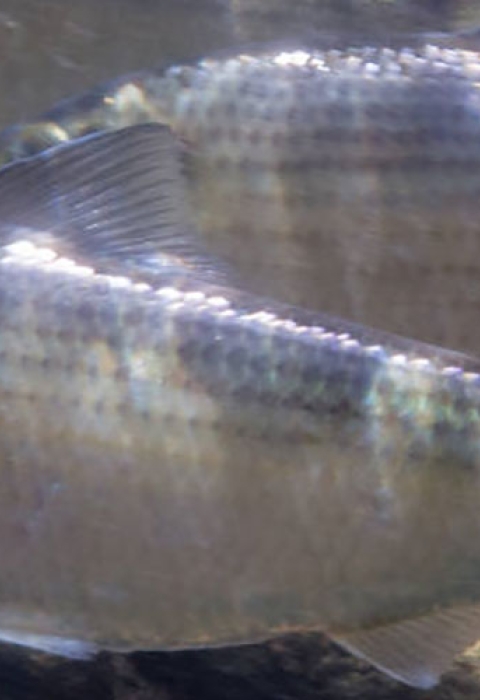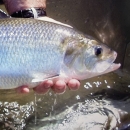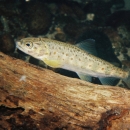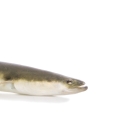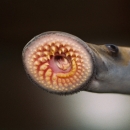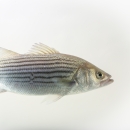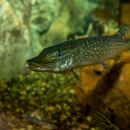Fishways have opened up hundreds of miles of river to migratory fish in the Connecticut River watershed! We know this because we count the number of fish passing through these structures. Knowing how many fish and what species use these fishways helps us make decisions on how to best restore our migratory fishes.
- The Leesville Dam on the Salmon River in Connecticut is monitored only for Atlantic salmon. The Salmon River joins the Connecticut River 18 miles upstream of the Long Island Sound.
- The Rainbow Dam in Connecticut is the first dam on the Farmington River, and is located 8 miles upstream of where the Farmington River joins the Connecticut River. The Farmington River joins the Connecticut River about 57 miles upstream of Long Island Sound.
- The West Springfield dam (formerly called the DSI Dam) in Massachusetts is the first dam on the Westfield River, and is located 4 miles upstream of where the river joins the Connecticut River. Westfield River joins the Connecticut River 75 miles upstream of the Long Island Sound.
- The Holyoke Dam in Massachusetts is the first dam on the mainstem of the Connecticut River, and is 87 miles upstream of the Long Island Sound.
- The Turners Falls Dam fish ladder in Massachusetts is 122 miles upstream of the Long Island Sound; The Vernon Dam fish ladder is located in Vermont, 142 miles upstream of the Long Island Sound.
- The Bellows Falls Dam fish ladder is located in Vermont, 174 miles upstream of the Long Island Sound.
| Fishway, River - State | Data as of | American shad | Alewife | Blueback herring | Atlantic salmon | American eel | Sea lamprey | Striped bass | Gizzard shad | Shortnose sturgeon | Other/ comment |
|---|---|---|---|---|---|---|---|---|---|---|---|
| Rogers Lake-CT | 5/28 | 13,545 | Mary Steube passed | ||||||||
| Mary Steube, Mill-CT
| 5/28 | 27,415 | |||||||||
| Mill Pond, Falls-CT (NEW Fishway) | 5/28 | 500 | |||||||||
| Moulson Pond, Eightmile-CT | open | bluebacks observed | |||||||||
| Leesville, Salmon-CT | no counts | bluebacks observed | |||||||||
| StanChem, Mattabesset-CT | open | very few river herring seen | |||||||||
| *Rainbow, Farmington-CT | closed | will not be operated | |||||||||
| W. Springfield, Westfield-MA | 5/23 | 3,392 | 2,162 | 539 white suckers | |||||||
| Holyoke, Connecticut-MA | 5/29 | 377,147 | 581 | 209 | 51,705 | 126 | 56 | 0 | |||
| Easthampton, Manhan-MA | open | passing sea lamprey | |||||||||
| **Turners Falls-Gatehouse, Connecticut-MA | 5/22 | 11,236 | 564 | ||||||||
| Vernon, Connecticut-VT | 5/10 | 885 | |||||||||
| Bellows Falls, Connecticut-VT | open | passing sea lamprey | |||||||||
Total to basin, only first barrier counts | 380,539 | 27,415 | 581 | 0 | 209 | 53,867 | 126 | 56 | 0 | ||
| Last year totals (2023) | 279,840 | 8,026 | 2,228 | 0 | 11,039*** | 22,681 | 116 | 60 | 64 |
*CTDEEP will not operate the Rainbow Fish Ladder due its documented poor performance and the lack of suitable downstream fish passage protection measures at the Stanley Works owned dam/project. Fish passage at this project has been the responsibility of the CTDEEP, due to FERC legal rulings.
** Spillway Fish Ladder - ; Cabot Station Ladder, base of canal, . Note that at Turners Falls Project (Dam/Canal) fish must use one of these two fishways first before having the opportunity to pass the final required ladder (Gatehouse).
*** Total collected from 3 eel ramp/traps at Holyoke in 2023
Sierra at Holyoke Fish Lift reports the following daily American Shad passage counts since last week; 5/23 (13,194), 5/24 (12,639), 5/25 (13,026), 5/26 (7,995), 5/27 (4,446), 5/28 (5,970) and 5/29 (6,787). The American Shad passage count to date is the highest since 2017, which was a good year (537,249 passed). Water temperatures and river discharge to date have been near "average" for time of year, creating excellent migration, passage, spawning conditions for many spring spawners. The Sea Lamprey counts are also at a level not observed since 2008, when 58,000 were passed at Holyoke. This week USFWS Fish Passage Engineer Jessica Pica, inspected Holyoke, Turners Falls and Vernon dam/projects fishways. Our USFWS River Herring Assessment this week had zero bluebacks sampled in our MA tribs areas, only two sampled in Farmington R, and modest catch rates in Wethersfield Cove (n=130 over five runs), a reduction from what will be our peak rate (catch) last week. Kevin Cheung (USFWS North Attleboro Hatchery) also provided some updates on the 300 shad his station has obtained (HFL) with expected egg production from natural spawning that they are incubating in their jar system. He is targeting 5 million fry into the Taunton River (MA) and 2 million into the Pawcatuck (RI) as part of our multi-agency restoration programs. He expects to have eggs produced through mid June by the brood fish he is maintaining in large circular tanks.
.
